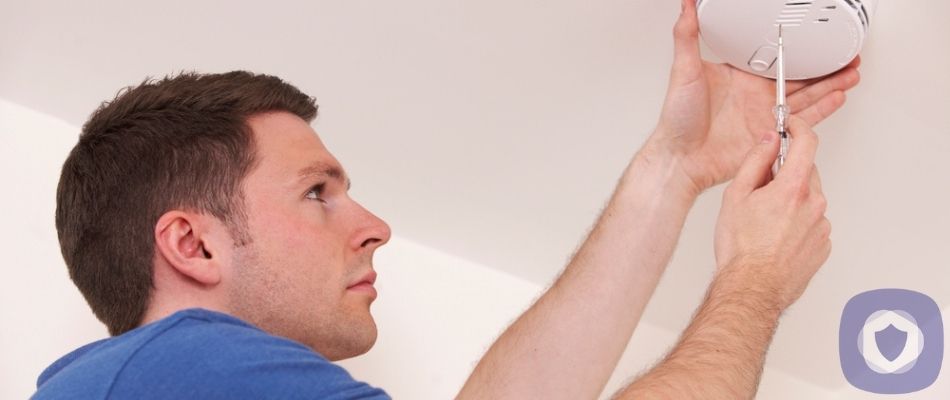Carbon monoxide detectors can save lives, but you need to know how to get the most out of your detector. An improperly placed carbon monoxide detector won’t be as effective in the event of a leak.
What is carbon monoxide poisoning?
Carbon monoxide is nearly impossible to detect, and it’s a colorless and odorless gas and one of the key dangers in the modern home. The Centers for Disease Control and Prevention says that over 400 people die, and 50,000 get hospitalized annually due to carbon monoxide poisoning – which usually occurs in a household setting.
Are you sure about your detector placement? Smoke detectors have been subject to many campaigns informing you of their importance and correct placement, but the carbon monoxide detector hasn’t had the same press. Read on to find out everything you need to know about carbon monoxide detector placement.
Where should you place CO detectors?
You’re not alone in being unsure how to install your CO detectors. You’re not alone. Carbon monoxide detectors aren’t as widespread as smoke alarms yet, which may leave you guessing when it comes to proper placement.
According to the Consumer Product Safety Commission, a good rule of thumb is ”on each house floor and outside sleeping areas”.
If you want to get more specifics, you’ll need to understand how carbon monoxide works and where it is in your home. It’s primarily produced by flame sources or fossil fuel burners such as wood burners, space heaters, cooking appliances (including gas stoves), water heaters, furnaces, and vehicles. It is lighter than air, which will make it rise and subsequently lead to CO poisoning.
The ideal height for a carbon monoxide detector is roughly 5ft above the floor, where it can measure air at the height that people breathe or at eye level. If you want to place it higher, you could put it on the ceiling around six inches from the wall. Check out our full explanation of how carbon monoxide detectors work.
Kitchen
You can install them in your kitchen – but the key here is to keep them away from the flame-producing appliances and direct sunlight. To avoid a false alarm, install your detector up to 20 feet away from a fire source (and at least 5 feet away).
Check out our picks for the best carbon monoxide detectors
Bedrooms
While the CPSC recommends at least one carbon monoxide detector on each level of a home and near sleeping areas, people often overlook that you can put one in the hallway outside of all bedrooms. Ideally, you should place it within a meter of each bedroom door, if possible. This will protect every bedroom and allow each occupant to hear the warning if CO gas is found. If you decide to have multiple additional detectors, you may want to place one in the bedrooms, too, for peace of mind. It’s most crucial that you’ll be warned while you’re asleep – the symptoms are so mild you won’t always wake up.
Basements
As per the International Association of Fire Chief’s recommendation, you should place at least one CO detector in your basement since water heaters and laundry machines represent little-known sources of carbon monoxide – and are common in the basement. In addition, installing a CO detector in spaces adjacent to a garage is a good idea, as vehicles produce large amounts of CO.
How to install carbon monoxide detectors
When installing, you should follow the manufacturer’s instructions that come with your new carbon monoxide alarm. However, here are the general steps for DIY installation. They may vary based on type:
- To avoid false alarms, you should keep your detectors away from heat or flame sources. You can mount your device at least 5ft above ground or on the ceiling no more than six inches from the wall. Some devices may plug into an outlet
- Trace and drill your holes with care and hang the mounting bracket
- Ensure you use new batteries
- Press and hold the ‘test’ button to ensure your alarm is functioning
- Attach the CO detector to the mount
Alarm maintenance
Just like smoke detectors, your CO alarm will require regular maintenance to keep you safe. You should replace your batteries at least yearly (even if they appear fine) and test them regularly – every six months or so is sufficient. Be sure to check out any strange beeping or flashing lights, as this may be a sign of an issue.
Replacing your detector
Unlike smoke detectors that let out chirpy warning sounds when the batteries need replacing, CO2 only does this when it’s time to replace them. You should anticipate replacing your CO alarms every five years, but you can also consult your manufacturer to double-check this.
Types of carbon monoxide detectors
There are three different types of detectors available. Which will be best for your home varies, so you should learn about each model.
- Smoke/CO dual detectors: Combination smoke and CO detectors are an all-in-one alarm, ideal for space-limited homes. Smart detectors often offer this combination; you get both in one rather than requiring a CO detector or smoke detector!
- Battery-operated CO detectors: These are the easiest type to install. Usually, they use sensor-based technology that reacts to extended or severe CO gas exposure. You can mount the device anywhere (and move it) as it’s not reliant on a fixed power source. However, you’ll want to ensure the detector has enough battery power for the next 12 months.
- Hardwired or plug-in CO detectors: Hardwired or plugged-in sensors are low maintenance because they don’t need batteries. However, this may mean you’re more likely to lose track of time and put off replacing it.
If your sensor goes off
You should always have a home safety plan to cover you in any event, such as a break-in or house fire, but you must have a plan that accounts for your CO alarm going off too.
You’ll need to act quickly if your sensor is triggered. Not all events will require calling emergency services; a first step is checking on everyone in the house. If anyone has any symptoms of carbon monoxide poisoning:
- Nausea
- Dizziness
- Headache
- Abdominal pain
- Shortness of breath
- Confusion
- Difficulty breathing
- Visual disturbance
- Unexplained drowsiness
You should evacuate the house immediately and call 911 for guidance; remaining is likely to cause extended exposure to CO gas. If any family members have symptoms, it’s expected that levels of carbon monoxide have reached a dangerous level. You can open windows/ventilate the property as you exit, but don’t stay too long to do so. You should wait outside or at a neighbor’s house for guidance from emergency services or specialists.
Wrapping up
Carbon monoxide poisoning is often called the silent killer for a reason – carbon monoxide detectors aren’t yet viewed as essentials for the American home, but the tide is changing. Still, it’s thought that only around 30% of American homes have a working carbon monoxide detector, which may contribute to the rate of deaths in homes. It would be best if you prioritized installing carbon monoxide detectors and placing them where they’ll be most effective.
This article has been reviewed and approved by Officer Banta.

Officer Banta is the official SecurityNerd home security and safety expert. A member of the Biloxi Police Department for over 24 years, Officer Banta reviews all articles before lending his stamp of approval. Click here for more information on Officer Banta and the rest of our team.

